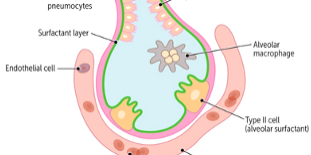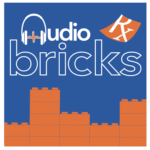Neonatal Respiratory Distress Syndrome


Preterm infants are at risk of breathing difficulties because their lungs have not had enough time to fully mature. In particular, they do not produce enough surfactant, which helps keep terminal air spaces from collapsing. Without surfactant, they cannot get enough oxygen into their body, and the body reacts with tachypnea (respiratory rate >60/min), tachycardia, cyanosis (the skin turns bluish), and grunting (the glottis closes in an attempt to increase functional residual capacity). This results in a condition called respiratory distress syndrome, and it is a hard thing to watch these babies gasp for breath.
Before we get into the details, let’s review what’s happening in the lungs during the transition from intrauterine to extrauterine life. A fetus in utero obtains oxygen and nutrients from the maternal circulation via the umbilical vessels. At this point, the lungs of the fetus are filled with amniotic fluid and do not perform their main function—gas exchange. The majority of blood in the fetus is shunted past the lungs by the patent foramen ovale and patent ductus arteriosus.
After listening to this AudioBrick, you should be able to:
- Define neonatal respiratory distress syndrome (NRDS) and list its risk factors.
- Apply Laplace law, lung compliance, pulmonary vascular resistance, and extra-pulmonary shunts to the etiology of neonatal respiratory distress syndrome.
- Differentiate between type 1 and type 2 alveolar epithelial cells and their role in neonatal respiratory distress syndrome.
- Discuss the clinical presentation of neonatal respiratory distress syndrome.
- Explain how the application of positive end expiratory pressure and exogenous surfactant improves patients with neonatal respiratory distress syndrome.
You can also check out the original brick on Neonatal Respiratory Distress Syndrome from our Respiratory collection, which is available for free.
Learn more about Rx Bricks by signing up for a free USMLE-Rx account: www.usmle-rx.com
You will get 5 days of full access to our Rx360+ program, including nearly 800 Rx Bricks. After the 5-day period, you will still be able to access over 150 free bricks, including the entire collections for General Microbiology and Cellular and Molecular Biology.
***
If you enjoyed this episode, we’d love for you to leave a review on Apple Podcasts. It helps with our visibility, and the more med students (or future med students) listen to the podcast, the more we can provide to the future physicians of the world.
Follow USMLE-Rx at:
Facebook: www.facebook.com/usmlerx
Blog: www.firstaidteam.com
Twitter: https://twitter.com/firstaidteam
Instagram: https://www.instagram.com/firstaidteam/
YouTube: www.youtube.com/USMLERX
Learn how you can access over 150 of our bricks for FREE: https://usmlerx.wpengine.com/free-bricks/
